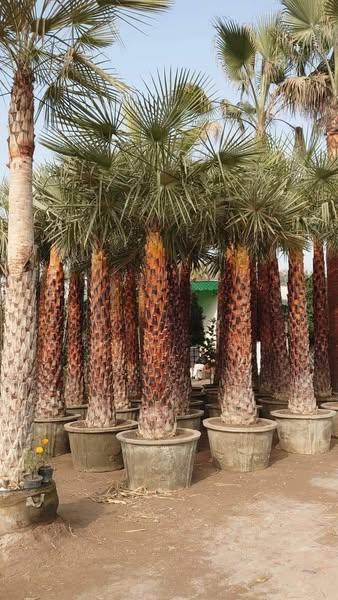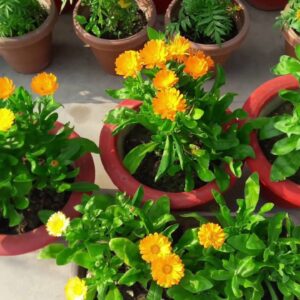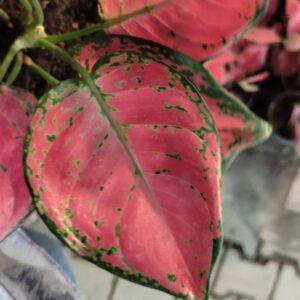Copernicia Palm “The shining star of tropical palms is the Copernicia Palm.
The Wax Palm, sometimes known as the Copernicia Palm, is a fan-leaved palm that grows slowly and is noted for its unique leaf texture and beautiful appearance. This palm, which is native to the Caribbean, Cuba, and some regions of northern South America, belongs to the Copernicia genus, which includes about 24 species. Among the most frequently farmed species are:
The national tree of Brazil is the Copernicia prunifera (Carnauba Wax Palm).
Copernicia alba
Copernicia baileyana
Copernicia hospita (the most decorative with silver-blue fan leaves)
The tall trunks, hard fan-shaped leaves, and waxy covering of all Copernicia palms contribute to their majestic tropical presence.
🌿 Botanical Summary
Scientific Name: Copernicia spp.
Copernicia Palm, Wax Palm, Carnauba Palm are the common names.
Family: Arecaceae
Kind: Fan palm with a single trunk
varies in height by species
C. prunifera: up to 40–50 feet
Baileyana C: 20–30 feet
C. hospita: 15–25 feet
Leaves: Rigid, spherical, fan-shaped, frequently bluish or silver
Trunk: Gray-brown, single, and straight, with rings of leaf scars.
Blooms: little, creamy or yellowish flowers arranged in big inflorescences
Fruit: Attractive, little, black drupe
Requirements for Climate and Sunshine
Sunlight:
Demands plenty of sunshine for optimal development and color.
At first, it can endure a little shade.
Temperature:
Prefers warm temperatures between 20°C and 38°C.
Tolerant of mild to severe cold:
The temperature range that C. alba can withstand is -6°C (Zone 9b).
Zone 10–11 is where C. hospita and C. prunifera thrive.
Humidity:
Performs well in subtropical climates that range from humid to dry.
☀️ Perfect for tropical gardens, coastal areas, or dry, sunny environments.
Needs for Watering
Palms in their youth:
Water 2–3 times a week until it’s established
The soil should be somewhat moist, not soaked.
Palms that are Mature:
Once established, it is drought-resistant.
Water every 10–14 days during dry spells
Reduce during the colder months
💧 To avoid root rot, make sure there is good drainage since standing water is bad for plants.
Requirements for the Soil
Type:
Loamy or sandy soil with good drainage is preferred.
Resistant to rocky, alkaline, or poor soils
pH Range: Neutral to mildly alkaline (6.5–7.8)
These palms are ideal for dry, coastal, or city gardens because they require little maintenance and can tolerate harsh environments.
Need for fertilizer
From spring through summer:
Use slow-release palm fertilizer (8-2-12 + micros) every 3-4 months.
Look for magnesium, potassium, and manganese supplementation.
Autumn & winter:
Pause or fertilize lightly throughout dormancy.
Potassium or magnesium deficiency may be indicated by pale leaves or spotting; use supplements as necessary.
✂️ Pruning and Upkeep
Little upkeep is required:
Only get rid of fronds that are dead or damaged.
Don’t cut green fronds since they feed the tree.
Trunk Maintenance:
Older leaves fall off the palm naturally, leaving behind a tidy trunk with time.
The smooth silver trunk of the Copernicia hospita plant, in particular, lends it a beautiful and neat appearance.
🌱 Multiplication
Using Seeds (Main technique):
Depending on the kind, the germination period is between one and three months.
In order for seeds to germinate, the ground must be warm and damp.
These palms cannot be divided since they don’t create suckers or offshoots.
🐛 Immune to Pests and Illnesses
Extremely durable, with hardly any recognized problems
may seldom draw aphids, mealybugs, or scale
Root rot can develop in soils with poor drainage.
The palm stays healthy with frequent airflow, careful pruning, and regulated irrigation.
🌴 Landscape Applications and Design Appeal
Ideal for:
Planting samples in lawns or medians
Formal tropical gardens
arid, xeriscaped environments
Hotels, resorts, and public parks
Matching Designs:
For striking contrasts, use with yucca, agave, bougainvillea, or bismarckia palms.
Due to its silver-blue leaves, which are ideal for contemporary or desert-style aesthetics, Copernicia hospita is highly sought after.
✅ Conclusion
The Wax Palm, also known as the Copernicia Palm, is a drought-tolerant, low-maintenance, and aesthetically pleasing palm tree that serves both practical and artistic purposes. These palms give landscapes a timeless tropical elegance, whether you select the beautiful C. hospita, the massive C. prunifera, or the cold-hardy C. alba. With the right amount of sunshine, well-draining soil, and a little patience, the Copernicia turns into a magnificent focal point that thrives for many years.”
Copernicia palm (Wax palm)
₨10,000.00
“The wax palm, also known as the Copernicia Palm, is a member of the genus Copernicia, which is native to the Caribbean and areas of South America, notably Cuba. The “”Queen of Waxes,”” the natural carnauba wax derived from the well-known species known as the “”Carnauba Wax Palm”” is known as **Copernicia prunifera**.
These palms have a thick trunk and a symmetrical crown of hard, fan-shaped leaves that are coated with a natural, waxy substance. They grow slowly. Due to this wax’s ability to aid the plant in retaining moisture, the foliage has a silvery or bluish hue and is extremely resistant to drought.
Copernicia palms do best in hot, dry climates with plenty of sunshine and well-drained soil. They are frequently employed as decorative statement trees in tropical or dry garden designs, botanical gardens, and public landscapes. They are both practical and lovely due to their magnificent shape and distinctive texture.”





Reviews
There are no reviews yet.